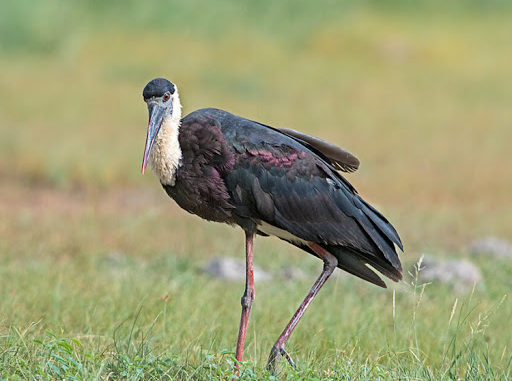
The International Union for Conservation of Nature and Natural Resources (IUCN) has the responsibility of assessing the status of all species on Earth. Species are graded on the level of threat they face on a global Red List, with ‘Critically Endangered’ referring to species that are close to extinction, and ‘Least Concern’ referring to species whose populations are doing well. The Red Lists take into account all available information to understand whether species populations are increasing or declining, what threats they may face, and other ecological aspects that relate to a species’ well being. The more ecological work on a species, the easier it is to give it a Red List rating. The Red List for birds is unique because it is conducted on openly accessible web-based forums. This is because birds are more widely present and apart from scientists, bird enthusiasts, hoteliers, photographers and film makers can contribute observations, experiences and thoughts towards developing status assessment for species that takes into account all available information.
This year the black-necked crane and woolly-necked stork of South and South-east Asia are being proposed for down listing to ‘Near Threatened’ levels. New information suggests that neither species are as threatened as they were assumed to be and this led to the decision. India has about 100 black-necked cranes, known as tung-tung in Ladakh. These birds fly into Ladakh’s high altitude wetlands to build nests and lay eggs during summer. These cranes are omnivores. In recent years, ferel dogs killed nearly all chicks that hatched, and wetlands in the Tibetan plataeu are under threat of development because nomadic pastora-lists built more permanent dwellings there. Tourism has had disastrous consequences for the sensitive high altitude wetlands.
This is in contrast with countries like China, where conservation efforts led by governments and non-profits have stemmed past declines of populations, and many new areas are now secured as protected reserves. Climate change, which led to greater glacier melt, potentially created new wetland habitats and, at least in the short term, has increased required habitats for the black-necked crane. So, available data suggests that keeping this species in a much higher level of conservation status on the Red List will no longer match the criteria that have been developed.
The down listing is greatly contentious with conservationists because they are concerned that this iconic species can no longer be used to help conserve habitats that are increasingly becoming disturbed by the human juggernaut. But the emotional response aside, the argument that a higher Red List status to these birds will protect them from the impacts of tourism or climate change has already proven untrue. The available data does not corroborate that claim. However, the Red List authorities have probably taken into consideration inputs that showed a very high list of habitat degradation of the black-necked cranes in the Indian limits and lowered it to the ‘Nearly Threatened’ category.
This is one of the least studied species of birds in the world. It was believed, for a long time, that these birds needed undisturbed wetlands inside forests and did not thrive around human presence. While this is true of its habitats in Southeast Asia, where illegal hunting is widespread, data about this ‘vulnerable’ species from India, Nepal, Bangladesh, Sri Lanka and Pakistan has presented a starkly different pictures. In these parts, the storks have been observed using farmlands even in densely populated states like UP, hunting for food beside farmers tilling fields, and nesting on trees and cellphone towers. So, in India these birds have done incredibly well almost entirely outside of protected areas, and their population estimates in India and Nepal alone are 1.2-3 lakh.
It is quite amazing how Indian farmlands have supported incredible numbers of these storks, leading to arguably their largest population in the world. Though this phenomenon has not been studies in detail, it can be attributed to the absence of widespread hunting in India, and the species getting accustomed to human presence on farmlands and in other habitats because they were left undisturbed. the overall ethos of co-existence has allowed the woolly-necked stork to thrive here and contribute to the growth of the species in India’s neighbouring regions as well.
Matter referenced:
Gopi Sundar, Scientist at Nationals Conservation Foundation, Times of India, Ahmedabad Edition, Monday, 3rd August, 2020.
By: Dr. Bhawana Asnani.
Happy to see Reviews, Additions, Suggestions and Comments, further.

Really appreciate you sharing this article post. Thanks Again. Want more. Corinne Pincus Drolet
Lovely just what I was searching for. Thanks to the author for taking his time on this one. Aubrie Kerwin Rains
Thank you for the good writeup. It in fact was a amusement account it. Look advanced to far added agreeable from you! By the way, how could we communicate? Gilberta Augustine Rafat
Do you have a spam issue on this blog; I also am a blogger, and I was wanting to know your situation; we have developed some nice practices and we are looking to trade strategies with other folks, be sure to shoot me an email if interested. Nanete Pavel Kiel
I blog frequently and I genuinely thank you for your content. The article has really peaked my interest. I will take a note of your blog and keep checking for new information about once per week. I opted in for your Feed too. Siouxie Martyn Malvina
Love the detective/noir feel. Thanks so much for these! Jeanelle Barri Orrin
Howdy! This post could not be written much better! Clementine Alaster Onida